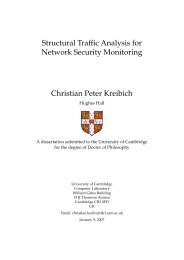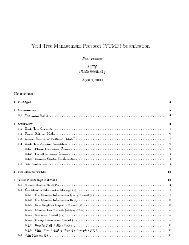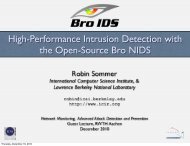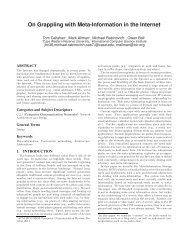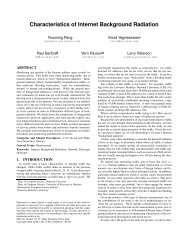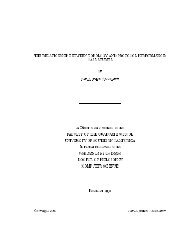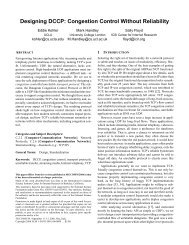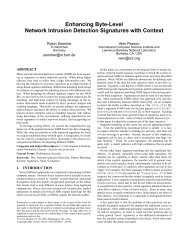SIFF: A Stateless Internet Flow Filter to Mitigate DDoS Flooding Attacks
SIFF: A Stateless Internet Flow Filter to Mitigate DDoS Flooding Attacks
SIFF: A Stateless Internet Flow Filter to Mitigate DDoS Flooding Attacks
You also want an ePaper? Increase the reach of your titles
YUMPU automatically turns print PDFs into web optimized ePapers that Google loves.
marking of privileged packets.<br />
4 Analysis<br />
4.1 Privileged Packet <strong>Flooding</strong><br />
<strong>SIFF</strong> mitigates the impact of flooding (or bandwidth<br />
starvation) DoS attacks by isolating and protecting established<br />
privileged communication from unprivileged communication<br />
and enabling the receiver <strong>to</strong> downgrade privilege.<br />
In this section, we analyze the robustness of our<br />
scheme against floods of privileged packets with forged capabilities.<br />
First, we derive the probability that an unauthorized<br />
router or end-host will be able <strong>to</strong> forge (by guessing) the<br />
appropriate capability <strong>to</strong> allow its packets <strong>to</strong> reach a potential<br />
victim. Recall from Section 3 the two parameters: x,<br />
the number of markings each router maintains in its window;<br />
and z, the number of bits per router marking. The<br />
probability that a randomly guessed capability will pass a<br />
particular router is given by:<br />
P (x, z) = 1 −<br />
(1 − 1 ) x<br />
2 z<br />
and the probability that a randomly guessed capability will<br />
pass all d routers in a path is simply P (x, z) d .<br />
Recall from Section 3 that the capability field must be<br />
large enough <strong>to</strong> accommodate the markings of all routers in<br />
the path (plus an additional 1 bit <strong>to</strong> indicate the first marking<br />
in the field), or else the markings of some routers will be<br />
pushed out of the field, and the capability (when used by<br />
the sender of that packet) will not pass the inspection of<br />
those routers whose markings were dropped. Table 1 shows<br />
P (x, z), the probability of successfully forging a capability<br />
<strong>to</strong> pass a single router, for reasonable values of x and z.<br />
x = 2 x = 3 x = 4 x = 5<br />
z = 1 0.7500 0.8750 0.9375 0.9688<br />
z = 2 0.4375 0.5781 0.6836 0.7627<br />
z = 3 0.2344 0.3301 0.4138 0.4871<br />
z = 4 0.1211 0.1760 0.2275 0.2758<br />
Table 1. Evaluation of P (x, z) (the probability<br />
<strong>to</strong> pass one router with a forged probability),<br />
for common values of x and z.<br />
Choosing a value for x (the maximum number of keys<br />
that are valid at any one time on a router) presents a trademalicious,<br />
the au<strong>to</strong>matic reply can be s<strong>to</strong>pped. Although always responding<br />
with a capability update wastes bandwidth, we present this mechanism<br />
for those concerned with maintaining IP as stateless at the endhosts. A<br />
stateful implementation of this system is straightforward, and preferred.<br />
off. As we show in Section 3.2.1, x must be at least 2, otherwise<br />
every key change would force an additional handshake<br />
between the client and server. Because a valid capability is<br />
one that matches any of the x capabilities in the router’s<br />
window, small values of x provide the smallest probability<br />
that a randomly chosen capability will pass through a router.<br />
(Table 1 shows this effect). The value of x also affects the<br />
validity time of a capability. The minimum validity time<br />
(min m ) is min m = (x − 1) · T K , where T K denotes the<br />
time a key (marking) is active (valid). The maximum validity<br />
time (max m ) is max m = x · T K . Ideally, we would like<br />
<strong>to</strong> get a small interval for the validity time, so that we can<br />
tightly control the validity period, so we would like large<br />
values of x <strong>to</strong> minimize the difference between min m and<br />
max m . We can determine x from min m and max m :<br />
max m<br />
x =<br />
max m − min m<br />
Because capabilities are only updated when the client and<br />
server send packets <strong>to</strong> each other, the min m metric should<br />
be set just low enough so that all handshakes and most<br />
packet traffic should be able <strong>to</strong> go back and forth from client<br />
<strong>to</strong> server within that time period. The max m metric defines<br />
the longest amount of time that a connection can remain idle<br />
and still have a valid capability. Put in another way, max m<br />
defines the maximum amount of time that an attacker can<br />
flood privileged packets with a particular capability, before<br />
that capability is rejected by the network. We leave the exact<br />
timing decisions <strong>to</strong> the community, and simply assume<br />
in our experiments that x is likely <strong>to</strong> be from two <strong>to</strong> five.<br />
Number of Paths<br />
20000<br />
15000<br />
10000<br />
5000<br />
champagne moni<strong>to</strong>r (Urbana, IL)<br />
f-root montior (Palo Al<strong>to</strong>l, CA)<br />
m-root moni<strong>to</strong>r (Tokyo, Japan)<br />
0 10 20 30<br />
Path Lengths<br />
Figure 3. Path length distribution for three<br />
CAIDA skitter moni<strong>to</strong>rs.<br />
In Figure 3 we show the plots of the path lengths of the<br />
<strong>Internet</strong> maps generated at three different CAIDA skitter<br />
moni<strong>to</strong>rs [9]. To analyze the performance of our scheme<br />
in filtering floods of forged privileged packets, we select<br />
8





